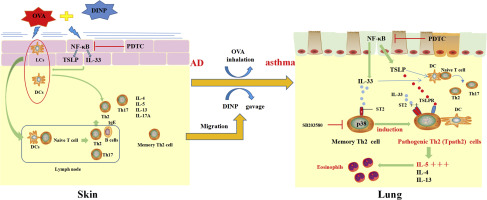Toxicology and Applied Pharmacology ( IF 3.3 ) Pub Date : 2020-03-30 , DOI: 10.1016/j.taap.2020.114981 Wei Qin 1 , Jiufei Duan 1 , Xiaoman Xie 1 , Jun Kang 1 , Ting Deng 1 , Mingqing Chen 1

|
What factors and underlying mechanisms influence the occurrence of the atopic march remain unclear. Recent studies suggest that exposure to diisononyl phthalate (DINP) might be associated with the occurrence of atopic dermatitis (AD) and asthma. However, little is known about the role of DINP exposure in the atopic march. In this study, we investigated the effect of DINP exposure on the progression from AD to asthma, and explored the potential mechanisms. We built an atopic march mouse model from AD to asthma, by exposure to DINP and sensitization with OVA. Pyrrolidine dithiocarbamate and SB203580 were used to block NF-κB and p38 MAPK respectively, to explore the possible molecular mechanisms. The data showed that DINP aggravated airway remodeling and airway hyperresponsiveness (AhR) in the progression from AD to asthma, induced a sharp increase in IL-33, IgE, Th2 and Th17 cytokines, and resulted in an increase in the expression of thymic stromal lymphopoietin (TSLP) and in the number of inflammatory cells. Blocking NF-κB inhibited AD-like lesions, and the production of IL-33 and TSLP in the progression of AD, while alleviating airway remodeling, AhR, and the expression of Th2 and Th17 cytokines in both the progression of AD and the asthmatic phenotype. Blocking p38 MAPK in the progression of asthma, inhibited airway remodeling, AhR, and the expression of Th2 and Th17 cytokines. The results demonstrated that exposure to DINP enhanced the immune response to memory CD4+ T helper cells through the NF-κB and p38 MAPK signaling pathways, leading to an aggravation of the atopic march.
中文翻译:

邻苯二甲酸二异壬酯暴露可通过激活NF-κB和p38 MAPK促进异位性进行。
哪些因素和潜在机制影响特应性行军的发生尚不清楚。最近的研究表明,接触邻苯二甲酸二异壬酯(DINP)可能与特应性皮炎(AD)和哮喘的发生有关。然而,关于异位进行中DINP暴露的作用知之甚少。在这项研究中,我们调查了DINP暴露对从AD到哮喘进展的影响,并探讨了潜在的机制。通过暴露于DINP和用OVA致敏,我们建立了从AD到哮喘的特应性行军小鼠模型。吡咯烷二硫代氨基甲酸酯和SB203580分别用于阻断NF-κB和p38 MAPK,以探讨可能的分子机制。数据显示,从AD到哮喘,DINP加剧了气道重塑和气道高反应性(AhR),诱导IL-33,IgE,Th2和Th17细胞因子的急剧增加,并导致胸腺基质淋巴细胞生成素(TSLP)的表达和炎性细胞数量增加。阻断NF-κB可以抑制AD样病变,并在AD进程中抑制IL-33和TSLP的产生,同时减轻AD进程和哮喘表型中的气道重塑,AhR以及Th2和Th17细胞因子的表达。 。在哮喘的进展中阻断p38 MAPK,抑制气道重塑,AhR以及Th2和Th17细胞因子的表达。结果表明,接触DINP可增强对记忆CD4的免疫反应 阻断NF-κB可以抑制AD样病变,并在AD进程中抑制IL-33和TSLP的产生,同时减轻AD进程和哮喘表型中的气道重塑,AhR以及Th2和Th17细胞因子的表达。 。在哮喘的进展中阻断p38 MAPK,抑制气道重塑,AhR以及Th2和Th17细胞因子的表达。结果表明,接触DINP可增强对记忆CD4的免疫反应 阻断NF-κB可以抑制AD样病变,并在AD进程中抑制IL-33和TSLP的产生,同时减轻AD进程和哮喘表型中的气道重塑,AhR以及Th2和Th17细胞因子的表达。 。在哮喘的进展中阻断p38 MAPK,抑制气道重塑,AhR以及Th2和Th17细胞因子的表达。结果表明,接触DINP可增强对记忆CD4的免疫反应+ T辅助细胞通过NF-κB和p38 MAPK信号通路,导致特应性行病加剧。











































 京公网安备 11010802027423号
京公网安备 11010802027423号